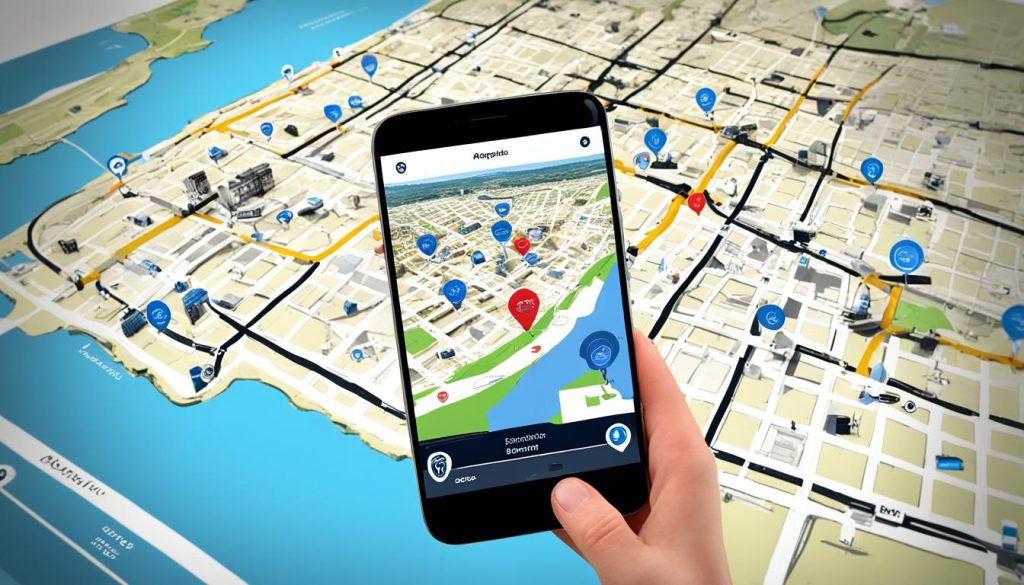App Development: Unlock the Power of Mobile Innovation
In the digital ecosystem, App Development is the bedrock of Mobile Innovation. It transforms our devices into tools that simplify our lives. Thanks to platforms like Apple’s App Store and the Google Play Store, we find countless applications to meet our needs.
When we interact with our screens, we access apps for every situation. Whether it’s connecting with others, boosting productivity, or enjoying games, mobile apps change the way we live. They are part of our daily routine, constantly adapting to our needs.
App Development is critical for ongoing tech innovation. It opens the door to new possibilities in the digital world. As we push forward, creating new apps and experiences, we shape the future of technology-driven convenience and enjoyment.
The Transformative Role of Mobile Apps in Daily Life
Modern technology has fundamentally changed daily life. It plays a crucial role in managing tasks, connecting people, and providing entertainment. Mobile apps, especially, boost productivity and enhance our social experiences. They are key in both our personal and professional lives, making them essential tools.
Seamless Integration and Enhanced Productivity
Mobile apps have broadened the reach of enhanced efficiency beyond the workplace. Tools like Google Drive, Microsoft Office, and Evernote have reengineered how we collaborate. They allow real-time document management and project tracking from anywhere. This transformation leads to enhanced productivity by streamlining tasks and minimizing delays.
Social Connectivity in the Digital Era
In the digital age, mobile apps are crucial for staying connected. Platforms including Facebook, Twitter, and Instagram offer more than mere communication. They connect people across cultures and continents, forming a global network. These apps encourage networking and shared experiences, changing the way we interact socially.
Entertainment and Gaming: A Mobile-Centric Approach
Mobile entertainment has redefined our consumption of media. Services like Netflix and Hulu provide on-the-go access to movies and shows. Additionally, the popularity of gaming apps ensures a diverse range of games for all. Everyone can find something enjoyable, right on their mobile device.
Key Drivers of the Mobile App Market Explosion
The mobile app market has seen remarkable growth, thanks to several key trends. These include the increased popularity of on-demand services and the growing accessibility of the internet. The addition of artificial intelligence has not only made apps more functional but has also boosted user enjoyment. This, in turn, has attracted more people to use them.
The Surge of On-Demand Services
The rise of on-demand services has greatly impacted the mobile app arena. It allows users to easily access various services and products. This evolution has been driven by the desire for instant gratification and ease of use, altering sectors like transport and food delivery.
Rising Penetration of Internet Access Globally
Global internet access has significantly expanded the reach and effect of mobile apps. The ability to connect in more places, including those with previously limited tech, has increased app user diversity. This has resulted in expanding markets and a boost in app usage.
Artificial Intelligence Elevating User Experience
The integration of artificial intelligence has turned mobile apps into intuitive tools that predict user wishes. By customizing experiences, apps become more attractive. They not only keep current users engaged but also draw in new ones with a personalized touch.

- Real-time customer service enhancements
- Personalized shopping recommendations
- Automated travel and navigation plans
As these advancements continue, they deeply influence how creators and firms approach app usage and interaction with users. Embracing these elements is vital for those aiming to leverage the market’s ongoing expansion.
Designing for Success: The Fundamentals of Mobile App Development
Every successful mobile application has at its core a well-crafted Mobile App Design that meets the specific needs of a Target Market. The use of UI/UX Design principles ensures apps are both beautiful and functional, providing a smooth experience. By following Agile Methodology, developers can quickly adjust to changes and efficiently include user feedback. This is crucial for keeping the app’s features up to date.
In Mobile App Design, knowing the target market is essential. Developers who focus on their app’s UI/UX Design to match the precise needs and wants of users often achieve higher engagement. This strategy, combined with Agile Methodology, results in apps that go beyond just being useful. They become indispensable tools for their users.
| Feature | Impact on User Experience | Importance in Agile Development |
|---|---|---|
| Responsive Design | Increases accessibility across devices | High – Iterative improvements |
| User Feedback Integration | Enhances functionality and satisfaction | Critical – Central to iterations |
| Market Research | Aligns app features with user needs | Essential – Guides feature backlog |
In Mobile App Design, employing Agile Methodology effectively depends on continuous testing and improvement. This keeps the development team adaptable and responsive to both the Target Market and new tech trends. Careful and strategic UI/UX Design significantly boosts an app’s appeal and user engagement. This leads to success in a fiercely competitive digital market.
Emerging Technologies Shaping the Future of App Development
The realm of app creation is endlessly shifting, spurred by advancements in mobile tech and refined user desires. Today, augmented reality, personalization, and updated security features are key in the world of app making. Each element significantly changes the landscape of mobile apps.
Enhanced Realism with Augmented Reality
Augmented reality (AR) marks a significant shift in mobile apps by adding dynamic, three-dimensional features. These features make the user experience more engaging. AR tech allows apps to place digital content on top of the real world via cameras. This blending of digital and real enables unique, immediate experiences.

Personalization Through Artificial Intelligence
Artificial intelligence (AI) has taken personalization in apps to new heights. By studying user patterns, AI customizes content and tools to individual needs. This personalization not only boosts engagement but improves app use and enjoyment.
Security Innovations Protecting User Data
In light of evolving cyber threats, solid security in app development is paramount. New security methods like biometric scans and complex encryption keep user data safe. This ensures trust and safety in our digital interactions.
App Development: Navigating the App Store Ecosystem
The app store landscape is always evolving, requiring developers to refine their visibility strategies. For those keen on App Store Optimization, it’s crucial to navigate this complex world effectively. This ensures better accessibility and user engagement for your app.
Mastering App Store Optimization (ASO)
For developers, App Store Optimization stands as a key strategy to increase their app’s visibility and downloads. This involves refining keywords, boosting app ratings, and creating a captivating app presence. Such efforts can greatly enhance your app’s position in the stores, driving acquisition and success.
Cross-Platform Availability: A Strategic Advantage
In the present multi-device environment, cross-platform development is critical and offers a competitive edge. It allows apps to function smoothly across various platforms, expanding their reach. This leads to a more varied user base, increasing both usage and retention rates significantly.
Overcoming Fragmentation in Multi-Device Environments
The challenge of handling multi-device environments often arises in app development. To combat this, creating flexible interfaces and utilizing responsive designs is essential. This ensures a consistent user experience, regardless of the device or operating system used.
Through these practices, developers not only boost their apps’ performance but also markedly enhance the user experience. This helps their apps stand out in a competitive market. A combination of App Store Optimization, cross-platform flexibility, and multi-device compatibility serves as a sturdy base for success in app development.
User-Centric Design: The Heart of Mobile App Innovation
At the core of stunning mobile apps is an intense focus on user-centric design. This approach supports great UI/UX design and the incorporation of user feedback. It also calls for a strong dedication to accessibility. These aspects are key to developing mobile apps that are cutting-edge and inviting for all.
Importance of Responsive UI/UX Design
Today, a mobile app’s success hinges on responsive UI/UX design. Its interface and experience should dazzle and be easy to use. Well-thought-out design is vital for user contentment and keeps them coming back. Hence, it’s a pivotal aspect of any app’s journey of development.
Gathering User Feedback for Iterative Improvement
Collecting user input is a must for fine-tuning any app continuously. This step allows for crucial refinements to the app’s operations. By updating based on feedback, apps stay valuable and meet user demands better. This, in turn, elevates the app’s appeal to its users.
Accessibility: Ensuring Inclusivity in App Design
Ensuring a high level of accessibility is crucial for engaging a wider market. It enables everyone, including those with special needs, to use the app. Adhering to accessibility guidelines doesn’t just meet legal standards. It also shows a commitment to designing for all, which boosts a brand’s image.
| Feature | Benefits | Impact on User Experience |
|---|---|---|
| Responsive Design | Enhances visual appeal and usability across devices | Increased user satisfaction and retention |
| User Feedback Incorporation | Enables iterative improvements, aligning app features more closely with user needs | Personalized user experience leading to higher engagement |
| Inclusive Accessibility Features | Expands user base by including users with different abilities | Creates a universally usable environment that enhances brand reputation and compliance |
App Monetization Strategies for Sustainable Growth
For developers to thrive in a competitive market, they must deploy efficient monetization strategies to ensure steady app revenue. The most favored models include in-app purchases and subscription models. They target distinct user engagement strategies and profit ratios.
In-app purchases serve a direct pathway for developers to enhance the app’s value. This may span from digital goods within games to access to advanced functionalities in productivity apps. Conversely, subscription models ensure a constant revenue stream. They do so by providing premium features for a steady charge. This approach shines for apps that continually deliver value, like entertainment or service-based ones.
| Monetization Model | Advantages | Disadvantages | Suitable App Types |
|---|---|---|---|
| In-App Purchases | Immediate revenue boost, enhances user engagement | Depends on high user volume, can affect user experience if intrusive | Games, Utility Apps |
| Subscription Models | Stable income, builds loyal user base | Requires continuous value delivery, high churn rate if not managed properly | Streaming, Productivity Apps |
To select an apt monetization strategy, deep comprehension of the audience and app’s core function is vital. Every model influences app revenue and user contentment. Developers must refine their chosen strategies continually. This should be based on feedback and market dynamics to achieve optimal results.
Ensuring Quality: Mobile App Testing and Deployment
In today’s digital world, mobile apps have become the lifeblood of digital experiences. So, making sure an app is of top quality before its launch is crucial. Developers engage in intense beta testing and user trials. These are done under real-world usage to check for potential issues affecting user experience or performance. As the app’s deployment nears, ensuring a smooth start requires diligent preparation.
Real-World Beta Testing and User Trials
Beta testing is more than just spotting errors. It involves selecting actual target users to thoroughly test the app. This ensures insights on the app’s user interface, functionality, and how it responds. Successfully, this step paves the way for a solid infrastructure capable of handling a wide user base without a drop in user satisfaction.
Deploying with Confidence: A Checklist for Going Live
Deploying an app is like sending a ship off to sea. Every detail, from design to performance, must be considered. A comprehensive checklist verifies the readiness for launch, including code reviews, security checks, and compliance with app store rules. Such meticulous preparation lays the foundation for developers to confidently release their apps, aiming to prevent any issues post-launch.
Cloud Integration for Scalable App Infrastructures
Building apps for today’s markets requires robust and flexible infrastructures. Cloud integration meets this need, offering scalable solutions that adapt to the app’s growth in users and data. A cloud-based setup enhances efficiency, handles load fluctuations, and supports the intricate data flows in modern mobile apps. Developers using cloud integration are prepared for their app’s success, ready to meet increasing user demands.




